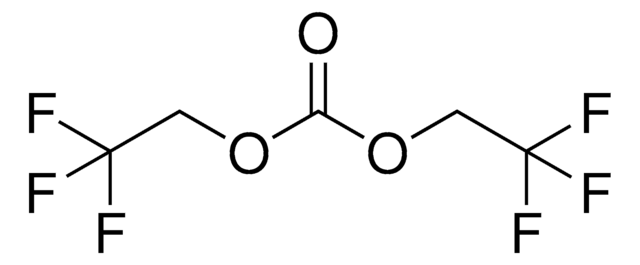Kluczowe dokumenty
287571
Bis(2,2,2-trifluoroethyl) ether
98%
Synonim(y):
2,2,2-Trifluoroethyl ether, Flurothyl
About This Item
Polecane produkty
Poziom jakości
Próba
98%
Formularz
liquid
współczynnik refrakcji
n20/D 1.300 (lit.)
bp
62-63 °C (lit.)
gęstość
1.404 g/mL at 25 °C (lit.)
grupa funkcyjna
ether
fluoro
ciąg SMILES
FC(F)(F)COCC(F)(F)F
InChI
1S/C4H4F6O/c5-3(6,7)1-11-2-4(8,9)10/h1-2H2
Klucz InChI
KGPPDNUWZNWPSI-UHFFFAOYSA-N
Szukasz podobnych produktów? Odwiedź Przewodnik dotyczący porównywania produktów
Zastosowanie
wyposażenie dodatkowe
Hasło ostrzegawcze
Danger
Zwroty wskazujące rodzaj zagrożenia
Zwroty wskazujące środki ostrożności
Klasyfikacja zagrożeń
Eye Irrit. 2 - Flam. Liq. 2 - Skin Irrit. 2 - STOT SE 3
Organy docelowe
Respiratory system
Kod klasy składowania
3 - Flammable liquids
Klasa zagrożenia wodnego (WGK)
WGK 3
Temperatura zapłonu (°F)
33.8 °F - closed cup
Temperatura zapłonu (°C)
1 °C - closed cup
Środki ochrony indywidualnej
Eyeshields, Faceshields, Gloves
Wybierz jedną z najnowszych wersji:
Masz już ten produkt?
Dokumenty związane z niedawno zakupionymi produktami zostały zamieszczone w Bibliotece dokumentów.
Klienci oglądali również te produkty
Nasz zespół naukowców ma doświadczenie we wszystkich obszarach badań, w tym w naukach przyrodniczych, materiałoznawstwie, syntezie chemicznej, chromatografii, analityce i wielu innych dziedzinach.
Skontaktuj się z zespołem ds. pomocy technicznej












